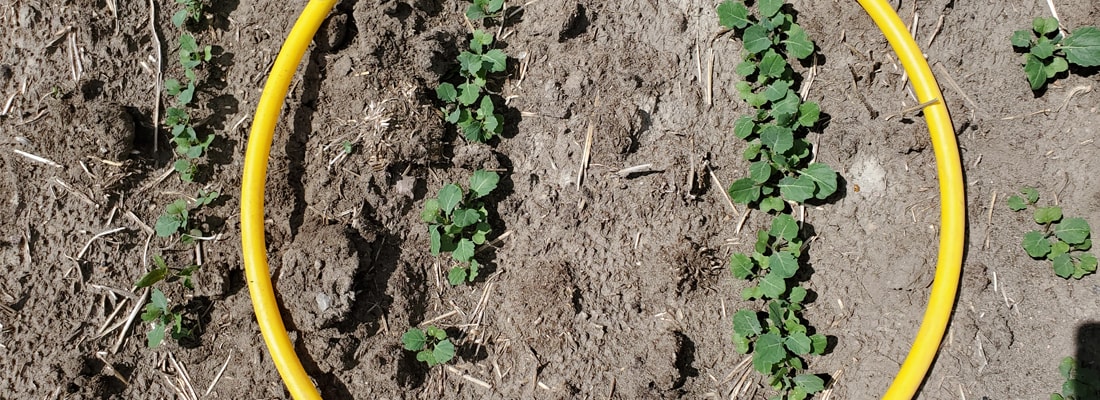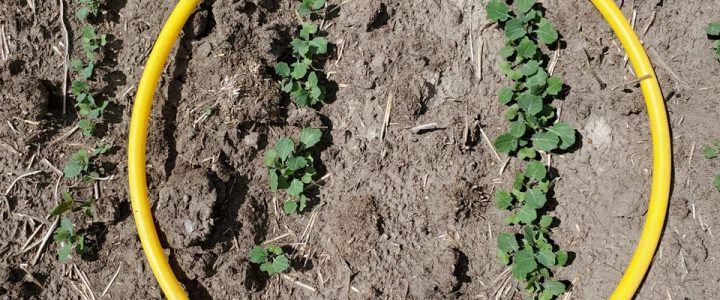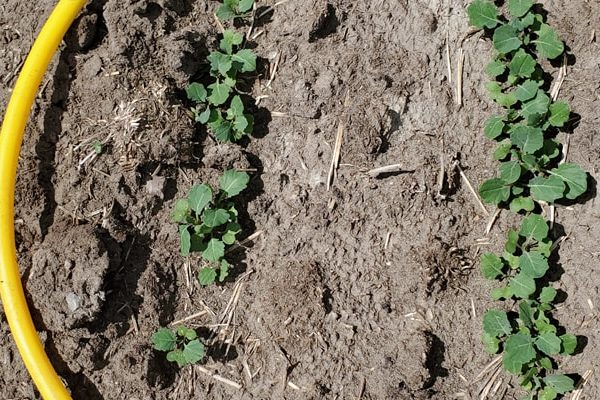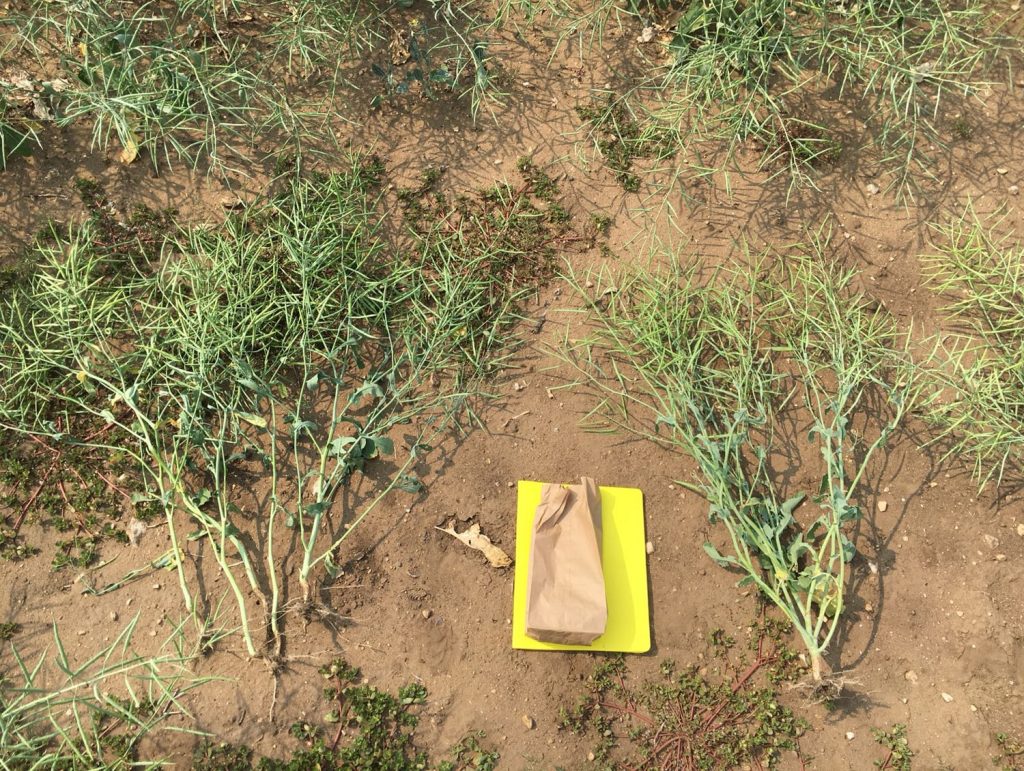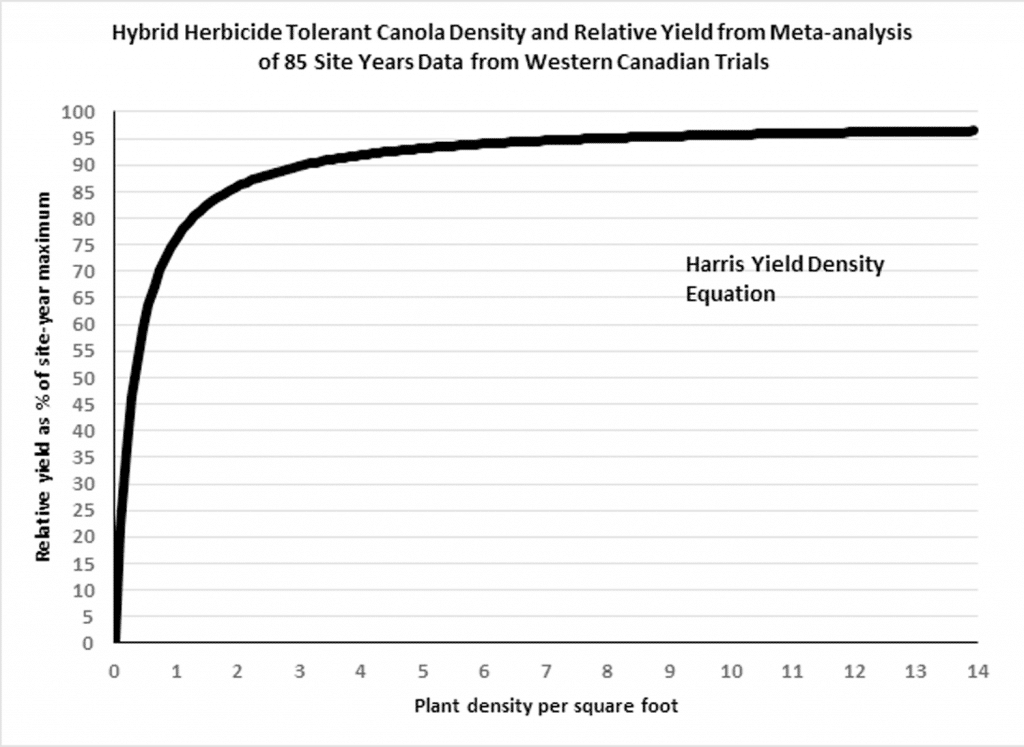A key factor to good plant establishment is an adequate plant population. The target plant population will impact a grower’s strategies for seeding (e.g. seeding rate), as well as in-crop management (e.g. weed pressure) and even harvest strategies (due to maturity timing). The plant population of a crop will also impact the plant architecture, crop competitiveness and eventual quality and yield.
Important tips for best management
- Prior to seeding, determine a target plant density (plant population) with the Canola Calculator.
- To realize the yield potential for canola, target a population of between 50-80 healthy surviving plants per square metre (five to eight plants per square foot).
- Note that yield potential and yield predictability are typically reduced when plant population drops below 30-40 plants per square metre (three to four plants per square foot).
- With a target plant density, calculate your optimum canola seeding rates and calculate seed costs using the Seeding rate calculator.
- After emergence, use another Canola Calculator tool to determine your actual plant density.
- Enter (and keep records of) your plant counts with Canola Counts, the crowd-sourced survey.
- See how your values compare to other regions with the Canola Counts maps.
- Read more in on assessing plant populations in Evaluating the stand.
Plant architecture
Canola is often called a flexible or plastic crop because individual plants can adjust the number and size of branches and pods they produce in response to available moisture, light and nutrients. Therefore, canola naturally compensates for variations in plant population over relatively wide ranges with very little effect on final yield 1, 2.
At plant densities of 70-100 plants per square metre (approximately seven to 10 plants per square foot), canola plants normally produce three to five secondary branches (in addition to the main stem). At low densities of 20-30 plants per square metre, canola plants can produce up to four times the number of branches that stands of 70-100 plants per square metre produce 3.
Canopy architecture
As the canopy becomes more dense (plant population increases), each plant produces less dry weight, thinner stems, fewer branches and fewer seeds per plant due to increased competition from adjacent plants. However, fewer seeds per plant are offset by a higher number of plants, resulting in similar seed yield per unit area compared with lower plant populations. This is why canola can produce similar yields across plant populations ranging from 50 to 200 plants per square metre (approximately five to 20 plants per square foot).
A canopy with too few plants will not fully utilize the available light, moisture and soil nutrients 4 and it will be less likely to reach its full yield potential.
In a canopy with more than 200 plants per square metre (approximately 20 plants per square foot), stems are very thin and pods are concentrated at the top of the plants. These stands are more likely to lodge, which can create a better microenvironment for diseases (such as sclerotinia) to flourish, and can make harvest more challenging. Severe lodging during bolting or early flowering stages may also directly impede the efficient uptake of moisture and nutrients through stem crimping, leading to lower yields.
When overall plant populations are lower than the ideal, stand uniformity becomes more important for overall yield potential. An Agriculture and Agri-Food CanadaAgriculture and Agri-Food Canada is a department of the Government of Canada. More study conducted in the Brown soil zone at Swift Current, Saskatchewan found that uniform canola populations at or below 40 plants per square metre (approximately four plants per square foot) were more likely to produce higher yields than non-uniform stands. The same study also found that when moisture is limited, stands with fewer than 40 plants per square metre (approximately four plants per square foot) yielded much lower than dense, more uniform stands 5.
Crop competitiveness
Moderate to high plant densities can improve crop competitiveness against early season weed growth because the canopy closes faster with more plants. With low plant populations, canola crops are slower to cover the ground and provide less competition to weeds in the early growth stages. Prolonged exposure to bare soil also increases evaporation of soil moisture.
Moderate to high plant densities in early growth stages can also reduce the yield impact of damage due to insects, disease, frost and hail, because the stand can afford some plant mortality and still maintain its yield potential. Low plant densities can produce viable crops, but the management of thin stands is more challenging, due to more variable maturity and lower tolerance for additional plant losses.
Maturity
Since canola plants in low population density situations grow larger and branch more, they tend to mature later. Secondary branches account for up to 80 per cent of the yield for canola crops with 20 plants per square metre (approximately two plants per square foot) 1, 2.
These secondary branches flower later and mature later than main stems, meaning thin crops will mature later overall.
The plants will also have a wider range of maturity, creating yield and quality losses simply due to inability to time applications that align with all the plants and harvest limitations. In these situations (with low plant populations and a wide maturity window) pods on the main stem may be dry with completely mature seeds while pods on secondary branches may still be green with watery seeds inside. Top pods may also start to shell out before pods on side branches are ready to swath, causing yield losses to occur no matter when a grower decides to swath this crop.
Extra branching in very thin stands (20 plants per square metre) can delay seed maturity up to 21 days depending on environmental conditions 3.
Yield
Canola crops need 30-40 plants per square metre (approximately three to four plants per square foot) to maintain yield potential. Plant populations lower than this are more likely to have yield loss 4.
Canola Council of Canada research found that stands of 50-60 plants per square metre (approximately five to six plants per square foot) yielded about five bushels per acre more than stands that averaged 20-30 plants per square metre (approximately two to three plants per square foot) 1, 2.
The recommendation is to target a population of 50 to 80 plants per square metre (approximately five to eight plants per square foot) to maintain maximum yield potential while providing some buffer for plant loss due to post-seeding stresses such as frost, seedling disease, wind or water, insects, weed competition or others. At a low plant population any additional plant mortality cannot be afforded without impacting yield potential.
Quality
Late-maturing crops are more likely to encounter a fall frost that can arrest the development of immature seed, causing shriveled seeds and higher chlorophyll levels and ultimately resulting in reduced grade or lost yield.
Plant population can even influence oil quality. Some studies have found that the highest oil content and lowest free fatty acid levels were found in plants grown with lower seeding rates. However, there are cases in which high seeding rates reduce maturity enough to avoid a fall frost, and produce lower green seed and chlorophyll content than plants grown in low seeding rates.
Footnotes
- Canola Council of Canada and University of Minnesota. 2003. Minnesota Canola Production Centre Results. Canada Canola Production Centre research, 1-28. Retrieved from: https://research.canolacouncil.org/_uploads/documents/cpc_mn_2003.pdf[↩][↩][↩]
- Canola Council of Canada. 2005. Plant Populations for Profitability. Canol@Fact factsheet[↩][↩][↩]
- Canola Council of Canada. Canopy Manipulation Trials.[↩][↩]
- Shirtliffe, S., & Hartman, M. 2009. Determining the economic plant density in canola. University of Saskatchewan[↩][↩]
- Angadi, S.V., Cutforth, H. W., McConkey, B.G.,& Gan. Y. 2003. Yield Adjustment by Canola Grown at Different Plant Populations under Semiarid Conditions. Crop Science, 43(4), 1358-1366. https://doi.org/10.2135/cropsci2003.1358[↩]
